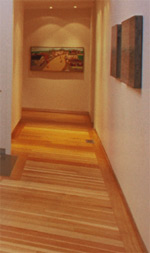
Flooring Options
By on Jun 17, 2008

For good reason flooring is often called the 'fifth
wall.' However - unlike the other 'walls' - almost no
other interior component will get as much wear andtear. What you choose might depend as much on a simple
childhood memory of stepping barefoot on yourgrandmother's ceramic tiled kitchen as it could on how you
cringed every time you wore dirty running shoes on yourmother's off-white carpeting. Flooring trends have shifted
in the past few years, trends have come and gone andreturned while reflecting an overwhelming move towards
home improvement and bringing the outdoors inside.
Flooring options are broken into five distinct categories:
wood, carpeting, laminate, resilient and ceramic/stone.Matching your homes' needs with your personal desires will
help you make the right decision. In the meantime consultthis New Dreamhomes breakdown for some guidance on
your flooring options.
Hardwood Floors
Hardwood floors are synonymous with the classic
Toronto home. Walk into any century old dwellingand you'll see just how durable it can be. Hardwood
floors are discouraged in the kitchen, bathroom andbasement since moisture issues will warp or change
the colour of the wood. Conversely, an extremely dryarea can cause the wood to crack apart. Provided you
vacuum regularly, hardwood floors can be a godsend for theallergy prone homeowner while precautions such as
buffers on the bottoms of furniture and theoccasional recoat with polyurethane will yield
long-lasting results. Hardwood floors are hardlycheap and do require installation, but, according to
realtors, this is widely considered worth theinvestment for its resale appeal.
Carpeting
If you are looking to obtain softness and warmth in the Canadian
climate, while minimizing the ambient noise and potential injuriesof a young and growing family, little can match carpeting as a
flooring option. A multitude of colours, texture and distributorsalso make carpeting a relatively affordable option although be
forewarned, quality does improve exponentially with the amountyou spend. The pitfalls of carpeting are well known: threadbare
where there is too much traffic and, despite the introduction ofstain-resistant fibres, stains are a fact of life. One should expect to
replace their carpeting every eight to ten years. Currently, frieze, amix of thick and thin yarns is the most popular form of carpeting.
Frieze appears to last longer as the fibres change position, therebywearing away on the top but also on the sides.

Laminate Flooring
introduced into the North American market in the last decade.
This thin plastic has had prolonged usage in Europe and iscomprised of three layers; a surface with printed design, a core and
a backing. Laminate flooring is most often made to look like wood and,unlike the real thing, laminate flooring can be used in moist areas.
Installation is simple, the method generally do-it-yourself and thematerial resists dents, stains and gouges. Due to its strength and
affordability, laminate flooring is particularly popular with thefirst-time homebuyer. Laminate flooring drawbacks are few, except that it
cannot be 'refinished' like hardwood floors.
Resilient
This category is a wide and encompassing, and includes vinyl,
rubber, linoleum and cork. As the name implies this flooring isbest loved for its comfort under foot and natural 'give.' Vinyl is
historically the most popular type, thanks to a plethora of looks, thedo-it-yourself ease and affordability. Linoleum peaked in
popularity in the 1950s and 60s and has surged in usage as newhomeowners embrace retro-styles. Though resilient flooring is very
durable, styles change and it does tend to show wear over the longrun. More often than not, it needs to be replaced every 10 years or
so, depending on the amount of wear and tear it receives. Inkeeping with the trend towards bringing the outdoors in, resilient
flooring is available in a dizzying array of 'natural looks' thatinclude earthen textures, natural stone, ceramic or wooden textures.
Ceramic or Stone
bathroom, primarily for its cool feel and easy-to-wipe
surfaces. With its Mediterranean or Southwestern roots,ceramic and stone lend a more exotic tone to the Canadian design
landscape. In more recent times, with the proliferation of loft andcondominium development tiles bearing concrete effects, a variety
of finishes have become more common. The look is decidedlyurban and sophisticated.While it is important to note that tiling
can be slippery when wet, it is resistant to moisture damage andeasy to install.


